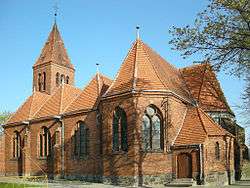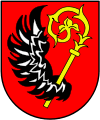Wąbrzeźno
| Wąbrzeźno, Poland | |||
|---|---|---|---|
|
Church | |||
| |||
 Wąbrzeźno, Poland | |||
| Coordinates: 53°17′N 18°57′E / 53.283°N 18.950°E | |||
| Country |
| ||
| Voivodeship | Kuyavian-Pomeranian | ||
| County | Wąbrzeźno County | ||
| Gmina | Wąbrzeźno, Polnd (urban gmina) | ||
| Established | 13th century | ||
| Town rights | 1331 | ||
| Government | |||
| • Mayor | Bogdan Zbigniew Koszuta | ||
| Area | |||
| • Total | 8.53 km2 (3.29 sq mi) | ||
| Population (2006) | |||
| • Total | 13,796 | ||
| • Density | 1,600/km2 (4,200/sq mi) | ||
| Time zone | CET (UTC+1) | ||
| • Summer (DST) | CEST (UTC+2) | ||
| Postal code | 87-200 | ||
| Area code(s) | +48 56 | ||
| Car plates | CWA | ||
| Website | wabrzezno.com | ||
Wąbrzeźno [vɔmˈbʐɛʑnɔ] (German: Briesen) is a town in Poland, in the Kuyavian-Pomeranian Voivodeship, about 35 kilometres (22 miles) northeast of Toruń. It is the capital of the Wąbrzeźno County. The population is 13,971 inhabitants (2004).
The town is the birthplace of Walther Nernst, a chemist who in 1920 received the Nobel Prize in Chemistry for the Nernst equation, which gives the standard electrode potential of an electric cell containing various concentrations of electrolytes.
History
At the beginning of the 13th century, a Prussian trade route developed that crossed over an isthmus between two large lakes, the Sicieńskie lake and the Zamkowe ("Castle lake"). A defensive wall was built at this spot, and later, a settlement was constructed there as well. The place is mentioned in a twelfth-century document regarding a battle in which Henry of Sandomierz was killed. Under the name "Wambresia" the town was mentioned in a 1251 Prussian Document issued at Chełmża. Bishop Heidenreich of Bishopric of Chełmno received the Chełmno Land from the pope. The Polish duke Konrad I of Masovia turned possession of the settlement over to the bishop of Chełmno. This created a problem because the Teutonic Knights were in control of the Chełmno Land, and a dispute began between the Bishop of Chełmno and the Knights. The Pope at the time, Innocent IV, was not keen to continue the dispute and installed the Bishop as the rightful ruler of the settlement. This disagreement was the first historical mention of the settlement. In 1251, a large church, St. Simon and Judah, was built in the city.
At the beginning of the 14th century, a revitalization of the church and the city was begun, led by the then-current Bishop of Chełmno, Herman von Prizna. A wall was also constructed around the city to further its protection, and a castle was constructed in the city's northwestern corner. However, the city, the wall, the surrounding villages, and the castle were all completely destroyed in the Thirteen Years' War between the Teutonic Knights and the Poles. Afterwards, all of these were reconstructed, and the castle at Wambresia served as the official residence of the Bishops until 1773.
After the end of the Thirteen Years' War, which ended with the Second Peace of Thorn (1466), the city became part of Poland, as part of the province of Royal Prussia.
The city was again totally destroyed, this time in 1655 by Swedes during the second Polish-Swedish war. A major portion of the city also burned down in a devastating fire in 1700.
After the First Partition of Poland in 1772, the city became a possession of the Prussian Kingdom, and between 1807 and 1815, the city was part of the Duchy of Warsaw. In 1788, the city was renamed Briesen, which is still referred to in German. Another devastating fire destroyed much of the city in 1792, after which the city's castle was used to supply stones for the rebuilding of the destroyed areas of town.
The residents of the city, mostly made their living through agriculture and brewing. Industrialization arrived in the middle of the 19th century. Industrial development flourished in the city due to its location and its access to railroads. By 1900, the city contained cement factories, as well as automotive and mechanical engineering centers. Along with this the traditional industries of the town were also modernized, with state-of-the-art breweries and creameries taking shape.
On January 20, 1920, the city became part of the Second Polish Republic, the Germanised name was removed and the name Wąbrzeźno was established, and was made seat of its county. The city was invaded by Nazi Germany during World War II, and was a German possession between 1939 and 1945. During this time, nearly 4,000 residents of Wąbrzeźno and the surrounding communities were sent to concentration camps. The Red army reclaimed the city, but this was hardly an improvement, as the Soviets conducted mass deportations even more extensive than those carried out under the German occupation. The city lost its status as county seat in 1975, but regained in 1999.
Historical population
- 1772: 502
- 1943: 10,051
- 1988: 12,396
- 1998: 14,283
- 2003: 14,523
- 2004: 13,971
People
- Ludwig von Erlichshausen
- Gisela Hahn (born 1943), German film actress
- Roy Henkel (1905–1981), German-Canadian ice hockey player
- Grzegorz Knapp
- Walther Nernst
- Franciszek Nogalski
References
External links
- Wambresia/Briesen 1251 Prussian Document from Pope for Heidenreich, Bishop of Kulm
- (Polish) Official town webpage
Coordinates: 53°17′N 18°57′E / 53.283°N 18.950°E



